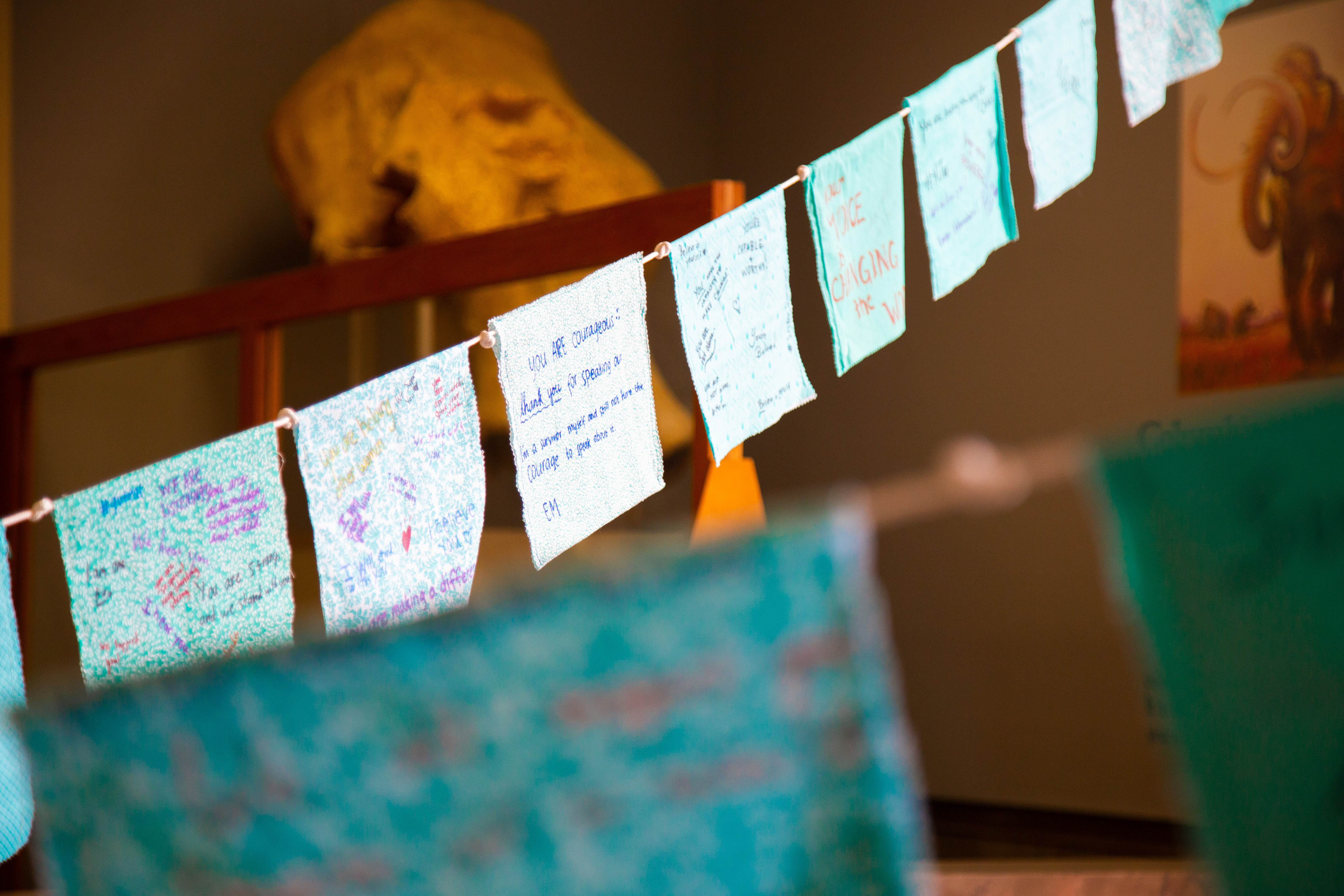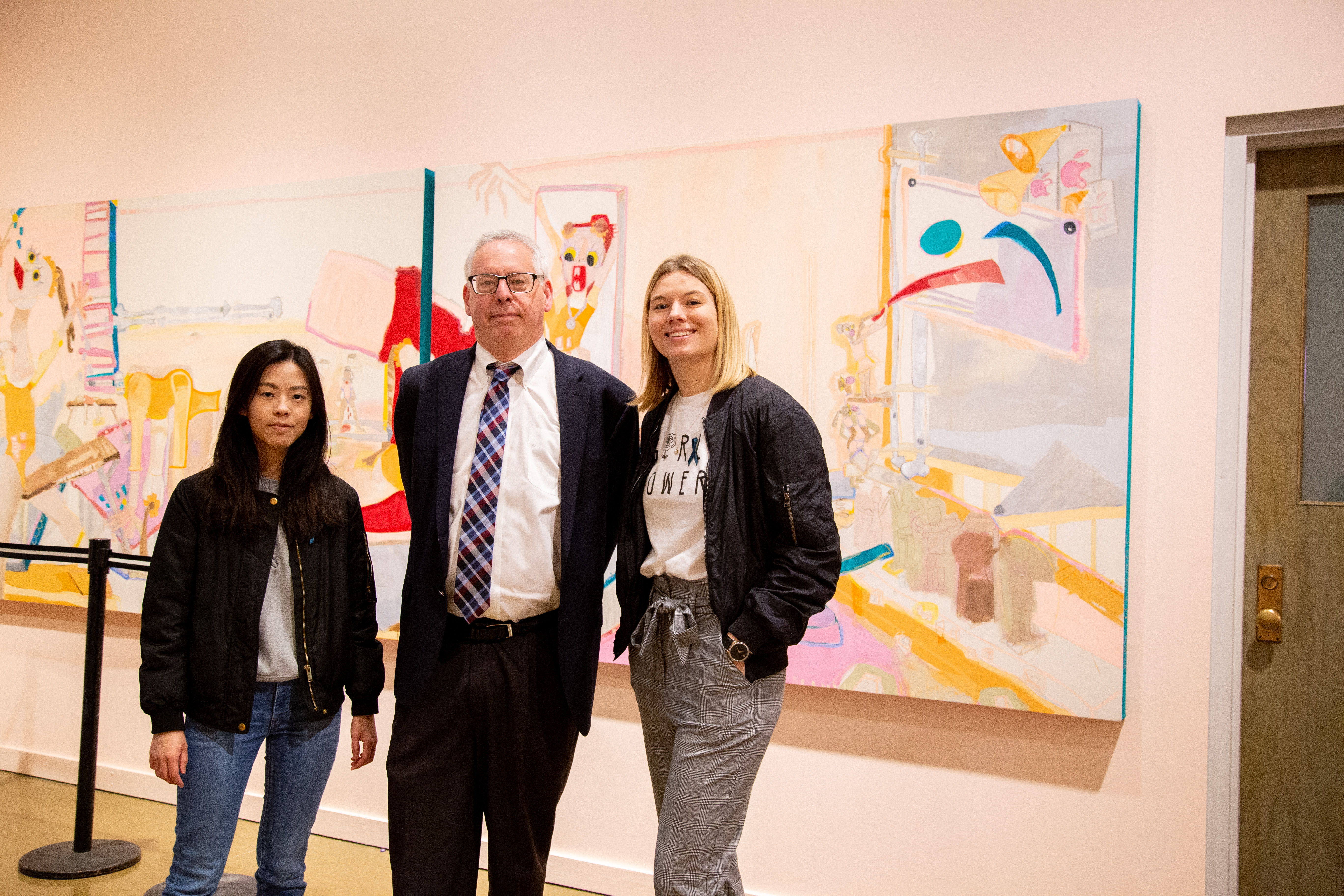In April, the MSU Museum Will Go Teal with ‘Finding Our Voice: Sister Survivors Speak’
Teal bows adorned tribute trees. Teal lipstick painted survivors’ lips. Teal ribbons marked the outfits of community members.
Last year, after former Michigan State University doctor Larry Nassar was sentenced to up to 175 years in prison for sexual assault, East Lansing turned teal as the community came together in support of his survivors.
In January 2018, Spartans were rocked by the first-hand accounts of dozens of Nassar’s victims during his sentencing; more than 150 patients and athletes told their stories. The number has since increased to include more than 500 victim impact statements. During the spring 2018 semester, it was the members of the MSU community – mothers, fathers, classmates, friends and professors – who took a stand, making a show of support.
Now, the MSU Museum is pausing to reflect, presenting an exhibit called “Finding Our Voice: Sister Survivors Speak.” The museum will be draped in teal, the color symbolizing sexual assault awareness, when the exhibit opens April 16. The items on display will capture both the natural and social history of an injustice that echoes across the campus, the country and the world.
“MSU was an epicenter to this terrible crisis, the worst sexual abuse crisis in American higher education,” Museum Director Mark Auslander said. “We were one of the scenes of the crimes. Now, we could be the scene of a change in how we, as a national and global culture, think about sexual assault and recovering from sexual assault. We need art to do that.”
The Timeless Impact of Tribute Trees
One of the first artifacts to arrive at the museum came from the trunks of tribute trees.
People rallied around the cause of sexual assault awareness and response, forming organizations such as the Army of Survivors, POSSE (Parents of Sister Survivors Engage) and others. Offering a visual sign of support, members used trees across MSU’s campus to recognize survivors’ suffering, tying bows of teal tulle around the trunks of 212 tribute trees.
Mothers and sister survivors would come to spend time with the tribute trees, which provided a safe place to reflect and a source of solace.
“Sometimes, it’s lost on the public,” said Danielle Moore, a survivor from the Army of Survivors. “A lot of people don’t talk about the mental health symptoms. We’re still dealing with PTSD and depression, the nightmares. It’s a lifetime of healing.”
By June, gypsy moths had nested in the tulle bows, finding the soft fabric ideal for birth and growth as they formed cocoons and webs.
“Every tree on this campus is an important part of a scientific collection,” Auslander said. “The tulle, with lots of little indentations in the large bows, proved to be a perfect nesting ground for the moths, so it was a kind of magnet.”
That summer, the gypsy moths reproduced at overwhelming rates. To protect the trees from harm, the ribbons needed to be removed.
Museum staff united with conservationists and others to save the teal bows to honor their meaning. They reached out to activist groups, inviting mothers and supporters to untie the ribbons in a ceremonial act. As each ribbon came down from a tribute tree, the name of the survivor honored was read aloud. Then the bows were cleaned and conserved with the help of museum staff, becoming a part of MSU’s history.
Bearing Witness
From the tribute trees, activism spread across campus. Beginning with the #GoTeal movement at MSU’s College of Communication Arts and Sciences, students voiced messages of respect, resilience and renewal.
“The exhibit started, for the museum and the archives, as a sense that they have a serious responsibility to document the stories of student and faculty activism,” Auslander said. “We started with the #GoTeal student activism to reclaim MSU, among other things.”
The goal of the museum exhibit is to commemorate the work of student activists and, above all, to provide a place where people can go to listen to the voices of survivors.
“This movement was led by students but supported by the entire community,” Amanda McCafferty said.
An alumna of the College of Communication Arts and Sciences, McCafferty helped organize one of the first major projects to support survivors on campus. As a student, she joined forces with fellow students Carlie Wirebaugh, Larraine Fu, Yi Rong and Tianyi Xie to paint the campus teal and raise awareness of the lasting effects of sexual assault. Many aspects of the #GoTeal movement will be on display in the museum, including a poignant short film and teal ribbons, as well as the striking portraits of survivors who donned teal lipstick to make an impression with a singular call to action: Speak up.
“The initial push of #GoTeal and its initiative was led by students, but its success and its impact would not have been what it is without the support of our community, such as MSU alumni, professors, our community, parents, brothers, sisters and more,” McCafferty said. “Our students stood in solidarity during one of the most horrific times in our school's history and came together for one reason: to support survivors.”
As 2018 continued, the activism across campus continued to swell.
“That’s something that (College of Communication Arts and Sciences) Dean Prabu David kept on saying: The soul of this university depends on us listening to the voices of the survivors,” Auslander said. “I think that moved a lot of us on the faculty.”
David’s message that the faculty and staff needed to stop averting their eyes – to avoid sinking into a resigned silence – inspired many people across MSU.
“Trauma, as (MSU psychology professor) Dr. Rebecca Campbell says, only ends when the victims – when the survivors – tell us that it’s ending,” Auslander said.

Metamorphosis as a Metaphor for Healing
“Finding Our Voice: Sister Survivors Speak” is a community curated exhibit, with direction and active participation from survivors and their supporters. The exhibit covers a vast array of emotions and reactions, including a look at the social and neurological impacts of sexual assault.
“It’s a concentric circle that keeps on growing,” said Auslander.
The exhibit will showcase banners, buttons, T-shirts and signs from student demonstrations on campus, among other pieces. It also will display “quieter work,” including a poem by a 13-year-old survivor.
“There’s an amazing series of poems by a 13-year-old survivor, who was 8 when this started,” Auslander said. “She and her parents have given permission for those poems to be included.”
Already, the MSU Museum staircase is adorned in Buddhist prayer flags. Teal in color, the flags are inscribed with messages of support from across campus. The exhibit also will feature a glass closet, containing athletic apparel and gear – clothing survivors no longer want to wear but can’t bring themselves to throw away.
Jordyn Fishman, an impacted gymnast and University of Michigan student, will exhibit her artwork. The large triptych painting depicts the story of the gymnasts from abuse to healing. Giving shape to the hope for healing, a dress fashioned by survivor Alexandra Bourque, a designer and textile artist also from the University of Michigan, will help to anchor the exhibit.
“She’s created 300 silk butterfly cutouts that are dyed different colors, that eventually move toward the color teal,” Auslander said.
The butterflies form a dress around a female figure that resembles a survivor in flight, in a metaphor imagined by the artist.
“We discover through those who have suffered,” Auslander said. “Taking them seriously and learning to listen; that’s how we find our way back.”
"I want the community to understand that how we talk about abuse matters, as it can easily set the tone to silence survivors and perpetuate a culture of abuse,” said Melissa Hudecz, sister survivor and co-curator.
“Finding Our Voice: Sister Survivors Speak” runs through March 30, 2020. An opening reception will be held from 5:30 to 7 p.m. April 16 at the MSU Museum.
“We have to talk about it,” said Moore, who coordinates mental health issues and research for the Army of Survivors. “That’s really where the suffering ends and the healing begins.”
By Melissa Priebe
